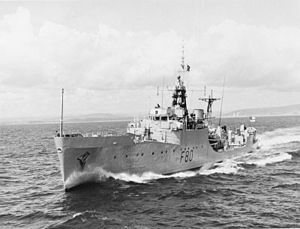HMS Duncan (F80)

HMS Duncan, July 1968 (IWM)
|
|
| History | |
|---|---|
|
|
|
| Name: | HMS Duncan |
| Namesake: | Adam Duncan |
| Builder: | John I. Thornycroft & Company |
| Laid down: | 17 December 1953 |
| Launched: | 30 May 1957 |
| Acquired: | October 1958 |
| Commissioned: | 21 October 1958 |
| Decommissioned: | 1984 |
| Identification: | Pennant number: F80 |
| Motto: |
|
| Fate: | Broken up February 1985 |
| General characteristics | |
| Class and type: | Blackwood-class frigate |
HMS Duncan was the fifth RN ship named after Admiral Adam Duncan. She was a Blackwood-class frigate of the Royal Navy that served in the Cod Wars.
From her first commissioning in 1958 until 1965 Duncan was the leader of the Fishery Protection Squadron. She was involved in the First Cod War between United Kingdom and Iceland over fishing rights, intervening between the Icelandic coastguard and British trawlers.
She was an escort to the royal yacht Britannia in August 1960. In 1964 Duncan fired the salute at the opening of the new Forth Road Bridge. The frigate also visited Nantes in 1961, Oslo and Reykjavík in 1963, and Copenhagen in 1965. She was given the Freedom of the city of Hull for the part the vessel played in the Cod Wars. In 1966 she completed an extensive modernisation at Rosyth Naval Dockyard and in the following year attended Portsmouth Navy Days.
In 1970 Duncan was again present at Portsmouth Navy Days, by this time she was part of the Portland Training Squadron.
During the early 1980s, Duncan served alongside the frigate Eastbourne as harbour training ship at Rosyth Dockyard for the marine engineering artificer apprentices from the shore base HMS Caledonia.
Sir Robin Knox-Johnson, who in 1968 was the first person to perform a single-handed non-stop circumnavigation of the Earth while also winning the Sunday Times Golden Globe Race, was a watch-keeping and communications officer on Duncan from January to April of that year.
...
Wikipedia
